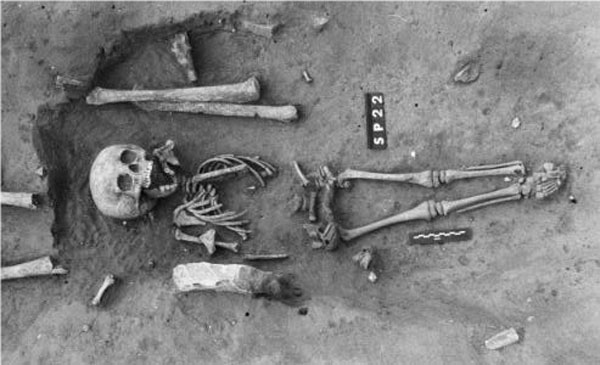Ancient burial of a child with Down syndrome reflects lack of stigmatization
Archaeologists have uncovered the oldest known remains of an individual with Down syndrome in a 5 th - 6 th century necropolis near a church in Chalon-sur-Saone in eastern France, according to a report in New Scientist. The features of the grave, which belonged to a young child, shows typical burial customs of the time and demonstrates that the child was treated no differently in death than other members of the community. While the researchers conclude that this suggests they were not stigmatized while alive, other scientists have claimed that this cannot be known with any certainty.
Down syndrome, or Down’s syndrome as it is also known, is a genetic disorder caused by the presence of all or part of a third copy of chromosome 21. It is typically associated with physical growth delays, characteristic facial features and mild to moderate intellectual disability. It was first described in the 19th century, but has probably existed throughout human history. However, there are few cases of Down's syndrome in the archaeological record.
The new study, published in the International Journal of Paleopathology, reports that the remains of the child displayed a short and broad skull, a flattened skull base and thin cranial bones, which enabled them to make the diagnosis of Down’s syndrome. The child was buried on his/her back in an east-west orientation with the head at the westward end. This was typical of burial customs of the time and the same as other deceased individuals uncovered at the necropolis. According to Maïté Rivollat at the University of Bordeaux in France, who has studied the skeleton with her colleagues, the fact that the child was buried in the same fashion as other members of the community hinds that they were not stigmatized while alive.
However, John Starbuck at Indiana University in Indianapolis said that this conclusion is debatable. "It can be very difficult to extrapolate cultural values and behaviour from burials or skeletal remains," he said.
In Ancient times many infants with disabilities were either killed or abandoned. A number of historical pieces of art are believed to portray Down syndrome including pottery from AD 500 from South America and the 16th century painting "The Adoration of the Christ Child".

The Adoration of the Christ Child (1515). Image source: Wikipedia
In the 20th century many individuals with Down syndrome were institutionalized, few of the associated medical problems were treated, and most died in infancy or early adult life. With the rise of the eugenics movement, 33 of the then 48 U.S. states and several countries began programs of forced sterilization of individuals with Down syndrome and comparable degrees of disability. Could it be that individuals with Down syndrome were treated better in the medieval ages than in the early 20 th century?



















